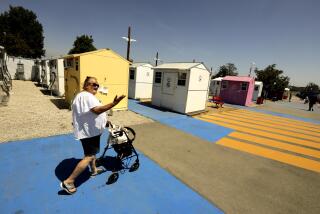Hug Brigade
Here at ground zero for National Hug Holiday, Jo Lindberg is mapping out a grand strategy for her all-volunteer force. This week, her personally trained “Hug Squads” will strike without mercy at senior care facilities across 17 states, including California.
Last year, the operation delivered a staggering 38,000 hugs to the lonely, the unsuspecting, the grumpy and the oh-so-happy. This year, the 36-year-old Orange resident is counting on an even higher body count in what is certainly the greatest organized hug campaign ever contemplated on American soil.
“I truly believe this is the reason why I’m alive,” says Lindberg, founder of the Hugs for Health Foundation. “There have been times that I thought to myself, ‘You know, Jo, you should just get a real job and quit this.’ But then I go to a senior center and see the reaction, and I know this is right.”
To Lindberg and her volunteers, hugs are an endangered species in America brought to the brink of extinction in recent decades by a rapidly changing world. Career opportunities have slowly uprooted once tightly knit communities, leaving people comparatively isolated and lonely in the nation’s big cities and cookie-cutter suburbs.
No group has been harder hit by the increasing sense of rootlessness than seniors, who a generation or two ago would have been cared for by loved ones, Lindberg says.
Instead, seniors in large part are segregated from the rest of society.
“They’re just a forgotten population; they think nobody cares about them. They’re starving for affectation,” says Lindberg. “I’ve had many who’ve broken down into tears from a hug.”
So, for the fourth consecutive year, Lindberg is massing the troops for another assault on human separateness and reserve. The weeklong campaign officially got underway Sunday as hundreds of volunteers from ages 10 to 77 established “Hug Centers” in dozens of senior care centers around the country.
Hug Centers are makeshift stations in senior care facilities that serve as a base to give out hugs to residents and visitors. The centers keep track of hugs with a “Hug-o-Meter” in hopes of meeting their hug quota.
“We encourage hugs all the time, but this really brings out the love even more,” says Cliff Johanssen, whose Hug Center at Anaheim Health Care distributed 4,000 embraces last year.
Like Lindberg’s other volunteers, Johanssen knows the value of a good hug. In 1992, he was robbed as he was dumping his trash at his Anaheim apartment building.
“They stomped the hell out of me,” he says. The beating triggered a diabetic coma that eventually forced doctors to amputate one of his legs below the knee.
It was then that Cuddles the Huggy Bear, the Ambassador of Hugs, walked into Johanssen’s hospital room. Cuddles is actually Lindberg outfitted in a fuzzy brown bear suit.
“I was lying there all alone. My family was in Northern California, and there seemed to be no one around who cared, and all of a sudden there’s this big bear in my room,” recalls Johanssen, 56, a senior activities director. “Cuddles gave me a hug. It was wonderful.”
Though a major undertaking, National Hug Holiday is only a fraction of what Lindberg’s foundation does year-round and on a threadbare budget of just $35,000. Usually dressed as Cuddles, Lindberg, either alone or leading a handful of hug volunteers, visits a dozen or so senior facilities in the Los Angeles area for one-day hug fests.
In a crowded room of seniors, Cuddles can move at speeds of up to 100 hugs per hour.
“It’s only a few seconds, but it can make all the difference,” Lindberg says.
The reaction to Cuddles and the hug volunteers is almost always positive. Most seniors love the attention and the personal warmth created by an embrace. Lindberg can recite story after story of an apparently crusty senior who cracks when confronted by Cuddles.
One woman, surrounded by friends, recently made fun of Cuddles when she came around and refused to even touch the bear. But on a subsequent visit, the same woman sneaked away from her group and gave Lindberg a hug.
“She was so cute. She came across the lobby on her walker,” Lindberg says. “She said that I’d made a lot of people happy on my last visit and then gave me a hug.”
But Cuddles takes his knocks from the rare senior--a “crab apple,” as volunteers call them--who just doesn’t want to be bothered. Claudia DiVito, 28, who substitutes as Cuddles on occasion, put it this way: “It can be scary in the bear suit. You get bopped in the nose every once in a while by a resident who doesn’t want anything to do with a 6-foot-tall bear.”
Like any good hug volunteer, though, DiVito overcomes such awkward moments.
“You pull away and don’t make any sudden moves. You don’t want to embarrass them,” says DiVito, an office manager from Tustin. “And you move on. You’ve got to let a lot of other people know they are loved and cared for.”


